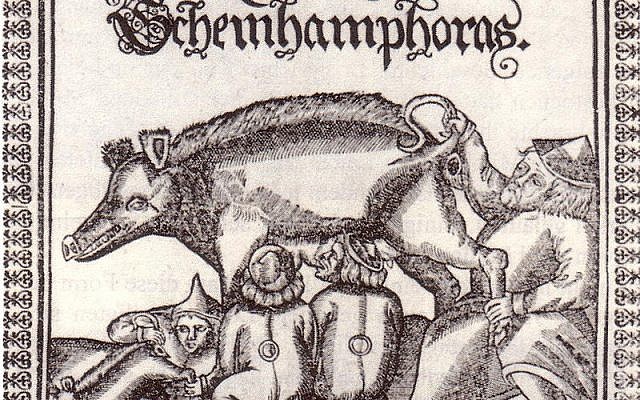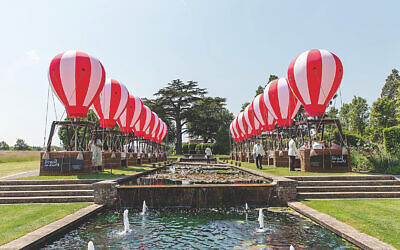Legal bid struggles to remove 700-year-old antisemitic carving in Germany
Lawsuit relates to infamous 13th century ‘Judensau’ relief that adorns the façade of the church in Wittenberg, where Protestant theologian Martin Luther once preached.

A legal campaign by German Jews to remove a 700-year old antisemitic carving etched into a church wall has found very little support from Jewish historians and educators in the UK.
The lawsuit relates to the infamous 13th century ‘Judensau,’ a sandstone relief that adorns the façade of the church in Wittenberg where Protestant theologian Martin Luther once preached.
It shows three young Jews drinking from a sow’s teats while a rabbi lifts her tail and hind-legs to inspect her backside for omens. It is one of 30 such reliefs to be found on European medieval churches, mostly in Germany.
Luther was the father of the Protestant Reformation and vehemently antisemitic, writing a 60,000-word essay titled: ‘On The Jews and Their Lies,’ in which he advocated burning synagogues, smashing up Jewish homes, destroying Jewish prayer-books, seizing Jewish property and forcing Jews into labour or expulsion.
Last year Michael Düllmann, 75, a member of a Berlin synagogue, sued and threatened to take the case to the European Court of Justice. He said the carving was a criminal offence against modern German Jewry and that Wittenberg should be stripped of its UNESCO World Heritage status if the Judensau was not removed.
Despite subsequent petitions and protests, the town council and the mayor said that while unpleasant, the Judensau was a testament to the antisemitism of its age and should be left as a reminder of the darker side of German history.
Last month the district court agreed, ruling that it was a “witness of its times” but Düllmann’s lawyers are appealing and the incoming bishop of the surrounding diocese is believed to favour the carving’s removal.
This week, educators and historians from the UK waded in.
Ben Barkow, director of the Wiener Library, said: “It is an authentic monument to a dreadful past. Removing it would be akin to trying to rewrite history. Should we demolish Auschwitz because it belongs to the horrors of history? No one would advocate such a thing.”
He added: “We cannot change history. We must come to terms with it. Removing historical monuments will not help us.”
Rabbi Baroness Julia Neuberger, who has just published a book on antisemitism, said: “It is truly awful but I think it is better to remember the history rather than destroy the cathedral frontage.”
Neuberger, whose family come from Germany, added that she would like to see “a monument near the cathedral that explains what it is or was and that memorialises the Jews from Wittenberg who were murdered”.
David Jacobs from the Jewish Historical Society agreed that the Judensau needed to be understood, not just seen. “It should be left as it is but visitors should have all the information necessary to contextualise it,” he said.
“This should be prominently displayed at the site, not hidden away, so they don’t see the images and leave disabused.”
Likewise Danny Stone, chief executive of the Antisemitism Policy Trust, said: “This shocking carving symbolises the ugly reality of antisemitism in the eyes of its creators.
“Rather than remove it, I’d support an accompanying educational board which highlights the grotesque anti-Jewish imagery for passers-by and details the importance of due diligence and outspoken opposition against antisemitism.”
Abigail Morris of the Jewish Museum criticised calls for it to be removed. She said: “The decision to force the removal of the Wittenberg Judensau essentially amounts to an erasure and denial of an antisemitic past. In the current climate, people urgently want to understand the history and causes of antisemitism. Rather than removing this difficult past we should be exploring it, using it as the basis to challenge racist attitudes then and now, to create a better future for all.”
Writing in The Times, Professor Geoffrey Alderman from the University of Buckingham said: “Although the reliefs are embarrassing and upsetting, their removal amounts to blatant iconoclasm”.
He said it would “involve the destruction of a historical record that bears witness not least to the salience of unashamed antisemitism in the medieval Catholic world”.
He added: “As a Jew myself I can understand the feelings of my German coreligionists who are pressing for its removal. I nonetheless hope that it will stay exactly where it was always meant to be.”

Thank you for helping to make Jewish News the leading source of news and opinion for the UK Jewish community. Today we're asking for your invaluable help to continue putting our community first in everything we do.
For as little as £5 a month you can help sustain the vital work we do in celebrating and standing up for Jewish life in Britain.
Jewish News holds our community together and keeps us connected. Like a synagogue, it’s where people turn to feel part of something bigger. It also proudly shows the rest of Britain the vibrancy and rich culture of modern Jewish life.
You can make a quick and easy one-off or monthly contribution of £5, £10, £20 or any other sum you’re comfortable with.
100% of your donation will help us continue celebrating our community, in all its dynamic diversity...
Engaging
Being a community platform means so much more than producing a newspaper and website. One of our proudest roles is media partnering with our invaluable charities to amplify the outstanding work they do to help us all.
Celebrating
There’s no shortage of oys in the world but Jewish News takes every opportunity to celebrate the joys too, through projects like Night of Heroes, 40 Under 40 and other compelling countdowns that make the community kvell with pride.
Pioneering
In the first collaboration between media outlets from different faiths, Jewish News worked with British Muslim TV and Church Times to produce a list of young activists leading the way on interfaith understanding.
Campaigning
Royal Mail issued a stamp honouring Holocaust hero Sir Nicholas Winton after a Jewish News campaign attracted more than 100,000 backers. Jewish Newsalso produces special editions of the paper highlighting pressing issues including mental health and Holocaust remembrance.
Easy access
In an age when news is readily accessible, Jewish News provides high-quality content free online and offline, removing any financial barriers to connecting people.
Voice of our community to wider society
The Jewish News team regularly appears on TV, radio and on the pages of the national press to comment on stories about the Jewish community. Easy access to the paper on the streets of London also means Jewish News provides an invaluable window into the community for the country at large.
We hope you agree all this is worth preserving.





















